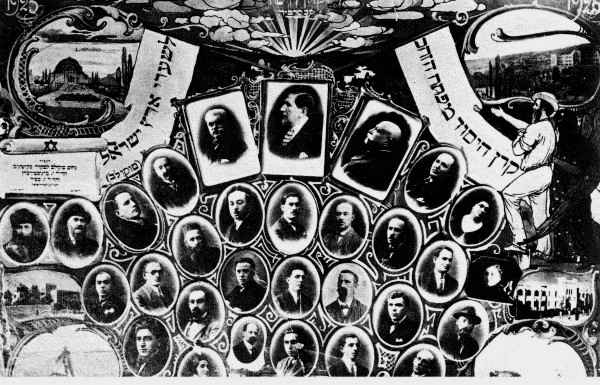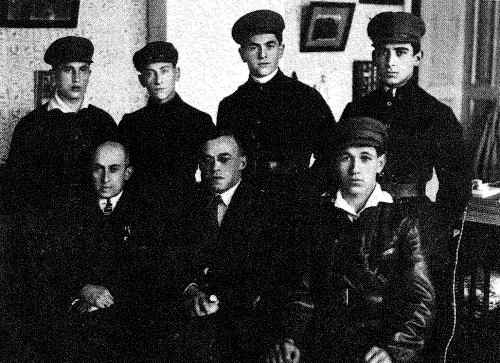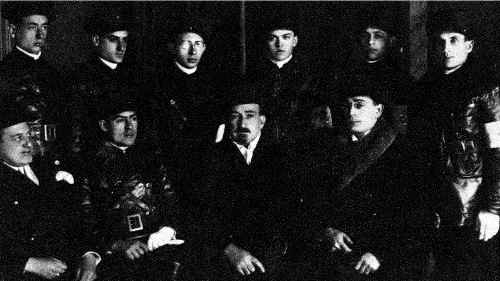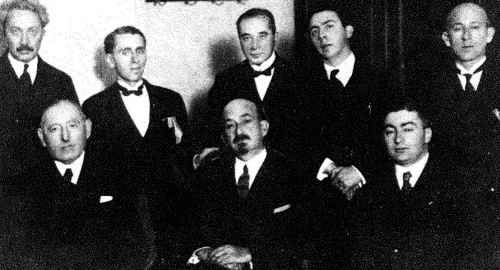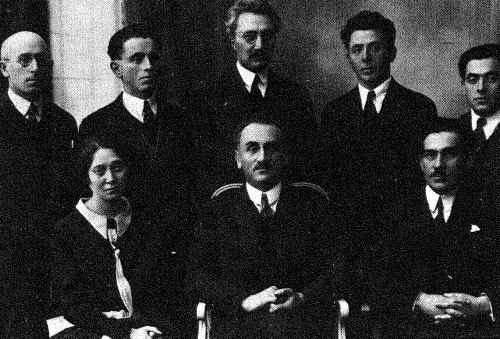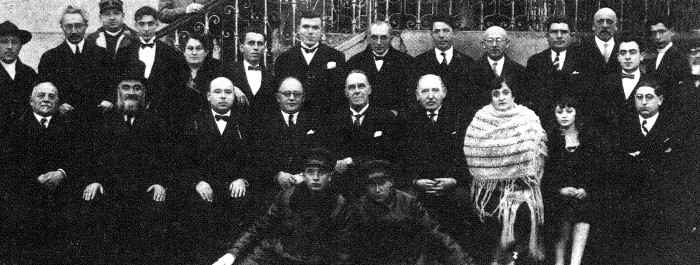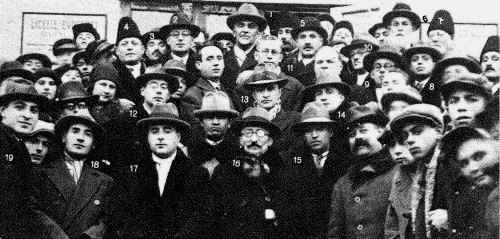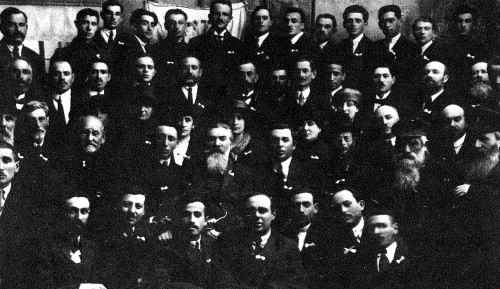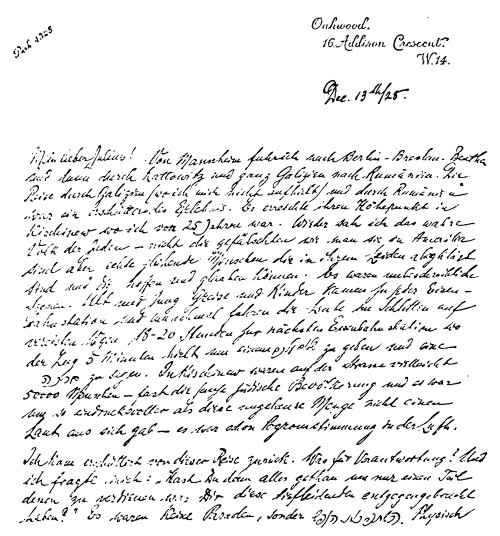[Page 98]
The Building of Eretz Israel {cont.}
Women's International Zionist Organization (WIZO)[1]
Women's organized groups dedicated to work for the social welfare existed in many towns in Bessarabia. When the Hebrew school system was set up after WWI it became necessary to mobilize the public's support for these institutions due to the lack of organized communities to take care of them.
Women's groups worked together with the local Tarbut organization and even had important results. The schools needed help feeding the children most of the time, but especially during drought periods and the women's groups were the ones in charge of this endeavor.
When Keren Kayemet and after that the Jewellery Fund were established, the women became more socially aware and active and worked towards the funds success.
The First Keren Kayemet Congress in the spring of 5684 (1924) with the participation of M. Ussishkin presented the women's groups with a new task – the redemption of Eretz Israel. Zadok Weinshtein and other Keren Kayemet representatives who visited Bessarabia thought of organizing the women in a separate organizationas. Even thought there was no central organization, the women's daily involvement with the Keren Kayemet activities was very well known.
Every year more groups were formed and in 5688 (1928) their number reached 19 groups. Very soon they became organized and affiliated with the women's organization in Kishinev led by Miriam Berger – a senior Zionist activist, the wife of Itzchak Berger, the new director of Keren Hayesod in Bessarabia.
A big awakening among the women's organization happened when Mrs. Leah Vidrovich – the envoy from the head office in Jerusalem visited Bessarabia on Tishrei 5691 (1931).
[Page 99]
Rapidly, the women's groups entered the circle of activities with all their forces competing with the senior Zionists. The number of men, because of their daily activities, started to shrink and the force and influence of the young Zionists were not enough to give to the Fund full value.
The women's groups started with Bazaars in many locations that attracted a large public with their novelty and because they were a change from the Keren Kayemet regular activities. The success of the Bazaars was also achieved with products from Eretz Israel – arts and crafts from Bezalel, hand crafted Yemenite jewellery, knitted items, pressure cookers (a technological novelty at the time), soaps from pure olive oil, shaving knives, etc.
Many women's groups in Bessarabia wanted to join the WIZO organization in Bucharest which operated with great success in Romania. Others considered WIZO an organization of society ladies doing philanthropy work instead of concentrating on the Keren Kayemet activities because in the Regat (Old Romania) they considered the Fund a popular cause for men who collected “pennies.”
The truth is that first and foremost the women of Bessarabia had in their hearts the Eretz Israel building interest. Also the situation of the women of Bessarabia being poles apart from that of the women of Romania, especially in the big cities was an obstacle to get together and to affiliate.
With time WIZO started to shed its “superiority” attitude and became closer to the Zionist Federation and to the Keren Kayemet activities. This change came especially after Hitler's rise to power in Germany when the danger increased for the Jews of Germany and Europe and the youth wanted to escape to Eretz Israel. This situation facilitated the affiliation of the Bessarabian women's groups to WIZO.
[Page 100]
The first stage was to bring all women's groups from Bessarabia under one organization. This became possible when Nathan Bistritzky, the known writer and head of the information department of Keren Kayemet in Jerusalem, visited Bessarabia in 5692 (1932) together with Leah Vidrovich.
The First Congress of the Zionist women opened in Kishinev on Cheshvan 7–8, 5692 (October 18–19, 1931) with the participation of Bistritzky and Mrs. Vidovich. 30 representatives (instead of 20) and many guests gathered in the large auditorium of the city hall. In his address “The Jewish Women and the Jewish Legend” Bistritzky succeeded to instill the love for the homeland in the hearts of the audience.
Leah Vidrovich presented a practical action plan to encourage Zionism, national spirit and a Jewish traditional athmosphere in each home.
Other speakers were: Shoshana Chokla on “The Jewish Women in History,” Devora Shwartzman on “Impressions from Eretz Israel” and Shoshana Berman on “The Cultural Mission of the Jewish Women.”
The organization gave the reports on its activities about the national education of the women towards the building of Eretz Israel and about Keren Kayemet.[2]
The Congress decided to work towards the development of cultural and national values amond the women; towards encouraging the volunteering for the national funds.
The elected Central Committee had 5 members from Kishinev – Miriam Berger, Shoshana Berman, Yehudith Geler, Shoshana Chokla and Devora Shwartzman, and Batya Dubianovkaya from Beltz, Weissman (Calarash), Sh. Yampolskaya (Leova), Rachel Nuta (Zguritza), Miriam Feldshtein (Akerman), Elisheva Klinger (Edinitz) and Rachel Shprintzin (Bender).
The most remarkable person at the Central Committee beside the Chairperson Miriam Berman (who was abroad during the Congress) was Yehudith Geler, a young woman who received a Jewish traditional education, a Tzeirei Zion disciple. She left her position as a lawyer to dedicate her time to the Women's Organization doing secretarial work and visiting various localities in the province.
After the Congress, the Secretariat started working on strengthening the local organizations and to open branches in main cities[3].
[Page 101]
In the two years between the Congresses, the number of branches doubled to 40.
The Second Congress took place on October 17–18, 1933 at approximately the same time with the Keren Kayemet Congress) with the active participation of Nathan Bistritzky and Itzchak Greenboim as a guest of honour.
Many details are missing, but it is possible to see the accomplishments of the Congress from the reports presented: to intensify the work for rebuilding Eretz Israel in general and Keret Kayemet inparticular; active participation in the fundraising for the “Ussyshkin Village” to honour Ussyshkin on his 70th birthday; to hold at least one bazaar during the year in every location; to intensify the cultural activities and especially the national education among all women; to conduct propaganda among the young women in order to mobilize them for national activities; participation in the local social work; to allow the Central Committee to enter in negotiations with the world WIZO to join this organization after the Zionist Congress will recognize it.
The plan to hold local meetings to attract the local women did not realize because of various legal and economical problems that prohibited the meetings. Only one meeting was held (February 1935) in Romanovka in the South of Bessarabia and somehow it succeded to attract the organizations and to encourage their activities. Among the participants at the meeting were: A. Kishinovskaya and Rachel Lackter (the secretary of the meeting) from Romanovka, Liuba Brodskaya (Tatar Bunar), Dora Goldman (Akkerman) Elizur and Feldman (Sarata), Rosenboim and Shpigel (Ceadir–Lunga) and Rosenblit (Tarutina).
Romanovka which was known as a Zionist centre hosted the meeting and contributed to its festive atmosphere and success. The chairman of the local Zionist Federation, Zeidel Turiansky and the council secretary Jacob Horwitz participated and presented greetings and lectured on the problems of the Zionist movement.
From the report[4] of the charperson we learn that since the Second Congress at
[Page 102]
the end of October 1933, they held 26 bazaars and the women's organizations contribution to the Keren Kayemet fund reached 30–35% from all proceeds. 35 out of the 40 branches were visited by the members of the executive council: Miriam Berger – 14, Dina Carol, Eretz Israel – 14, Yehudith Geler (3), Dora Goldman – 1 and Liuba Brodskaya – 1.
The Third Congress took place in Kishinev on Elul 18–20, 5695 (September 16–18, 1935). The reports presented by the chairperson Miriam Berger and by the secretary Yehudith Geler[5] show a development of the women's organizations in Bessarabia in the last 5 years since inception. In 1931 there were 18 centres while now their number is 44 with 2,500 members. A strong conection was established among the branches through correspondence and personal visits from the central committee. The women participation grew in the area of aid for the educational institutions and in the activity of Keren Kayemet and in general was geared to raising the national awareness.
During 5694–5695 (1934–1935) 40 bazaares were held – two each in Ismail, Akkerman, Artziz, Bolgrad, Bender, Vadul–Rashkov, Vartujeni, Tatar Bunar, Tarutina, Lipkani, Soroca, Cheadir–Lunga, Capreshti and Rezina, and one bazaar was held in each of these localities: Beltz, Brichani, Teleneshti, Leova, Manzir, Marculeshti, Novoselitza, Secureni, Kaushani, Kishinev, Romanovka and Rishcani.
The bazaars raised 408,342 Lei out of the 700,000 Lei raised by other organizations.
The question of affitiation with WIZO got a positive answer due to a change in direction taken after the Seventh Congress in Prague and the Eight Congress in Tel Aviv, i.e to raise the importance of Zionism and to work towards the training of Pioneers and immigration.
From the reports we learn that the most active chapter was in Soroca under the leadership on Mrs. Fanya Fleksor. Due to her dedication in the last three years the chapter raised 100,000 Lei, a large sum considering that the town was very poor.
[Page 103]
The Bender chapter led by Mrs. Rachel Shprintzak raised 90,000 Lei by holding 3 bazaars; the Lipkani chapter raised 60,000 Lei (out of the 90,000 Lei collected there) and the small chapter in Cheadir–Lunga raised in 7 months 17,000 Lei.
The following important decisions were taken at the Congress: it's crucial to raise the Zionist awareness together with the WIZO awareness and to adhere to the Zionist Federation discipline; the members of WIZO should not only work for the schools, but should give a Jewish education to their own children and strive to learn Hebrew; they should work for the benefit of the two national funds and influence the head of the household to raise the annual contribution to Keren Hayesod; the chapters should refrain from joining a party; to establish chapter of Young–WIZO.
It was also decided to approve the affition to the International WIZO after Mrs. Miriam Berger negotiated with the international organization.
This was Miriam Berger's last action for WIZO in Bessarabia. She served seven years the organization and left because she immigrated to Eretz Israel. The Congress praised her dedication and successes and as recognition her name was inscribed in the Golden Book of the Keren Kayemet.
The Congress elected a new executive committee with Advocate Yehudith Geler as chairperson, Chaya Polinkovskaya, secretary, Devora Lozovik, Shoshana Chokla and Sara Keinarskaya and other members from ouside Kishinev for the plenum.
The Fouth Congress, scheduled for January 1938, was indefinitely postponed because of the political situation in general and the rise to power of the anti–Semitic party of Goga–Cuza. Even when this fascist party was toppled, there were no conditions to work and held bazaars (see: the Chapter on the Keren Kayemet).
The Congress took place on 12–13 Kislev 5699 (December 5–6, 1938) parallel to the Keren Kayemet Congress. The following members were elected to the leadership: Rachel Shprintzak (Bender), Batya Dubinovskaya (Beltz), Malca Dorfman (Kahul), Yehudith Geler and Skomorovskaya (Kishinev). Rivka Eigret (Secureni), Komarovskaya (Tatar Bunar) and Yamima Nisenboim (Kishinen) secretaries.
The reports presented by Y. Geler and Ch. Polinkovskaya about the activities in last three years since the Third Congress show that the working conditions were favorable for WIZO in 5696 (1936), when the economic situation was flourishing in Eretz Israel and the Zionism was improving. The regular visits of the members of the Central Committee to the provincial localities in the same
[Page 104]
year, and especially the visit of Mrs. Esther Kaplan from the Keren Kayemet Head Office in 15 locations created a confortable working atmosphere that allowed a development in the cultural activities of the organization.
Young–WIZO chapters were established in 11 locations, the cooperation with WIZO in Bucharest grew and a few members of WIZO Bessarabia participated at seminars that took place there. In 1936, WIZO collected a total of 400,000 Lei for the Keren Kayemet (270,000 Lei came from the 20 bazaars).
In the following years, 1937 and 1938, the economic crisis and the legal situation caused a decrease in activities; the number of the bazaars decreased (18 in 1937) and only 200,000 Lei were collected. The entire year's proceeds were about 300,000 Lei.
In 1938 with the rise to power of the anti–Semitic party of Goga–Cuza and the ban of money collection, the proceeds decreased in a very serious way, totaling about 100,000 Lei from the women's organization. The total collected by WIZO during the following 3 years was about 800,000 Lei.
Yamima Nisenboim reported on the activities of Young–WIZO. Most of the activities were a reflextion of the mother organization, but this branch also had its own initiatives such as: discussions, lectures and the establishment of the summer camps for girls in Borisovka, Bender and Vatra Dornei in Bucovina. The cultural activities were done in cooperation with the Zionist students.
The attempt to establish a training Kibbutz was not successful due to the legal situation that forced the youth organization to go underground. In general this organization had a lot of difficulties to adapt to the difficult conditions in the land.
The Fourth Congress suggested to enlarge its membership and to attract counselors and instructors to visit regularly the chapters. The month of December was designated as recruitment time for new members. It was also decided to increase the work for the Funds and emergency plans were set up.
The Central Committee new members elected at the Congress: Chava Ortenberg, Tanya Gutman, Yehudith Geler, I. Levinshtein, Yamima Nisenboim, F. Nemirovskaya, Chaia Polinkovskaya, Shoshana Chokla, Tzilya Rosenshroich and R. Shuper. Members from the provincial localities were elected for the plenum.
[Page 105]
The participation of Meir Ha–Ezrachi from the Head Office in Jerusalem and the Advocate Joseph Pagis, the new chairman of the Bessarabia Keren Kayemet at the Congress, contributed to create a very festive atmosphere at the closing session.
The women participation to the Keren Kayemet proceeds of over 5 million Lei was exceptionally great in 1939 (see the Chapter on Keren Kayemet). The bazaar alone raised in Kishinev more than 100,000 Lei.
Footnotes:
- This chapter is an appendix to the chapter on Keren Kayemet because the main work of the women's groups was in the framework of the Keren Kayemet Fund. Return
- The Circular of the Central Committee of the Zionist Women Organization, no. 1, November 9, 1931 Return
- Circulars no.2 and 3 from November 18 to December 11, 1931. Return
- Undzer Tzeit, 3, 3711, February 1935 Return
- From the minutes Return
[Page 106]
The Keren Hayesod Fund
The Jews of Bessarabia responded with great enthousiasm to the decision of the annual Zionist Congress in London (5680/1920) to establish the Keren Hayesod. Before the publication of the first calls and before having a formal organization in Bessarabia, funds started to pour in to Kishinev from private initiatives. The first signal was gived by the Khotin district, second in size after Kishinev, with a population of more than 50,000 Jews. The decision was taken in Briceni on the Second and Third day of the Intermediate days of Suckot 5681 (1921).
1921 was the first year of Keren Hayesod. At the meeting of the Zionist centres with the participation of Dr. Michael Shwartzman from the London office, an interim central committee was established led by Dr. Jacob Bernstein–Cohen. Engineer Mordechai A. Gottlieb was elected treasurer. It was decided to temporarily stop collecting money, to start an extensive publicity campaign and to encourage the members of the Zionist centres to visit the provincial localities in order to organize the work and mobilize everyone in the community.
A system of delegates was established and Yeshayahu Klinger was invited to serve as secretary. Meetings were held to coordinate the local preparations and a census of population and their profession was conducted in order to impose the “tax (tithe).”
Dr. Bernstein–Cohen, Dr. Shwartzman, the general secretary of the International Zionist Congress, Dr. Landman, who was in Kishinev at the time and Chaim Greenberg who came from the Ukraine lectured at the January 20 meeting. A detailed plan was approved for the Keren Hayesod fund and for the Jewellery Fund. Mrs. Helena Babitz, one of the noted activists, was elected chairperson of the Jewellery Fund.
The decision to start the fundraising campaign was taken at the meeting of March 14 at the Express Theatre where 3,000 people participated. Dr. Bernstein–Cohen, Dr. Shwartzman, Chaim Greenberg, Zeev Tiutman (representative of the European Relief Committee for the Ukrainian pogrom victims) and Joseph B. Shechter were present.
Immediately after, visits to the provincial localities started with the
[Page 107]
participation of Advocate Israel Trivush, Dr. Yehudah–Leib Vilensky and Chaim Shorer (Hapoel Ha–Tzeir and He–Halutz representative).
After month of preparation in most of the important town, a First Congress was held in Kishinev on August 9, 1921 and an executive committee was elected. This congress gave every activist the opportunity to meet with the leadership and to get inspired in their mission.
The Jews of Bessarabia enthusiastically approved of the Tax “tithe” and immediately started implementing it. The local Keren Hayesod branches established special assessment committees to justly calculate the contributions.
Many years, Leova with a population of only 2,800 people ranked first in donations. During 1923 and 1924 it collected half a million Lei, mostly cash, a 9–10% of the annual proceeds in the entire Bessarabia[1].
Leova became an example by collecting 180 Lei per person and the entire town was very proud to fulfill its obligation for Zion. After that, Leova placed second to Kishinev (with donations of 10,000 Lei per family). (Details are missing for the following years, until 1928).
The Jews of poor Bessarabia, plagued by droughts, especially in the South contributed exceptionally to the Funds. The campaign reached a multitude of household and was very popular.
In the report of December 31, 1922 it is mentioned that Bessarabia collected 8,048.14 Sterling pounds and 3,933 pieces of Jewellery were collected in 1921 by the Jewellery Fund.
[Page 108]
These items were kept in the Keren Hayeson safes due to the lack of export permits. After 2 years they had to auction the items and transfer the money.
Until December 31, 1923, the poor Bessarabia transferred to the London office a total of 11,085 Sterling pounds compared with 12,401 Sterling pounds from old Romania which was a lot richer that Bessarabia.
Despite that, the financial help of the Bessarabia Jewry to Eretz Israel was not significant. The tithe tax did not always succeed due to the poverty, the fluctuation Romanian currency (Lei) and the lack of emigration. The peasants and even the middle class, who were so enthusiastic about Eretz Israel at the beginning hoped to liberate themselves from the harsh life in the Bessarabia and join the builders of Israel, like their brothers did by fleeing to great distances and working the lands of the Argentinian Diaspora. Very soon they realized that their hope is lost in the bitter reality of lack of popular settlement possibilities. This disappointment also affected the work of the activists. The economic situation caused a sharp drop in family incomes to a level that a donation of 1 Pound sterling (1,000 Lei) became a significant sum in the budget of a middle class family. Rich families were very few in general and not too generous in particular, but still donated something so not to be left outside the community.
The Jews of Bessarabia kept the tradition and were a source of encouragement to the leaders who still visited here from time to time.
The Keren Hayesod publicity work was pushed aside due to the harsh living conditions, but when a delegation came to visit in a town it was received with great honours and it became a bright event in the grey life and a pledge to connect with Eretz Israel, the land of its redemption.
The topic of the lectures included beside the situation in Eretz Israel a variety of subjects related to Hebrew and international literature, the situation of the young generation, the status of women in the society, etc. These days filled the local community with joy and significance.
[Page 109]
The tradition was to meet the Fund representatives dressed in the best holiday clothes, Stars of David on the lapels, led by young people on horses and accompanied by the Maccabi orchestra that created a holiday atmosphere. In the community of Faleshti during such an event, the treasurer of the synagogue, a very pious man stood up after a lecture on immigration of pioneers given by one of the volunteer delegates, the representative of Hapoel Ha–Tzair, and shouterd: “Gentlemen, I believe with complete faith that the thugs who destroyed the Temple, will rebuilt the temple.”[2]
When the women donated their jewellery for the Jewelery Fund the entire congregation applauded and when Dr. Bernstein–Cohen presented the first Keren Hayesod Certificate to one of the donors he shouted in Hebrew: “Shehecheyanu” (Who has given us life)! The donor was so emotional, he had tears in his eyes and hugged and kissed Dr. Bernstein–Cohen. The audience was elated and this event became etched in memories for a very long time.
Dr. Joseph Sapir, a Kishinev born, followed as chairman after Dr. Shwartzman, the first coordinator of the fundraising in 1921. Dr. Sapir lived in Odessa and was among the first Zionist activists in South Russia. Dr. Sapir came to Kishinev in 1923, after the Keren Hayesod activities stopped in 1922 because of the devaluation of currency and the decline in the economy.
Dr. Bernstein–Cohen was elected chairman of the Central Committee, Shlomo Meir Berliand and Rabbi Polinkovsky as vice chairmen. Dr. Sapir, David Rablesky and Jacob Wasserman who served as supervisor for the Tabut schools (first secretary) were elected to the excutive committee. Eliezer Drachlis was appointed second secretary.[3]
The delegates did an excellent job on publicizing the campaign and the results were impressive: in the first three months the donations reached more than 4 million Lei. Until the end of 1923 donations from the 48 localities reached 6,802.142 Lei (5,279,171 Lei in cash) more than 1.5% than in the previous campaign.[4]
This was an extraordinary achievement in the reality of the difficult economic crisis in Bessarabia and that mostly the empoverished people participated.
When Dr. Sapir lived in Odessa, he edited the popular “Zionistishe Kopeike–Bibliotek” (the Zionist Penny Library) and at his initiative they decided to continue the publications under the name “Zionistishe Folks Bibliotek” (the Zionist Popular Library). Due to the lack of propaganda materials in Yiddish the Zionist management decided to use their own money to finance the publications. The first edition had 5,000 brochures which were distributed widely in Bessarabia and all the Yiddish speaking countries. Soon they published 11 propaganda brochures which were praised by the Zionist press.
The Visit of Nachum Sokolow, Chairman of the Zionist Federation
Sokolow was the first Zionist Federation leader to visit Kishinev. He was an honoured guest in Romania and was invited to dine with the king and meet with important ministers and political personalities. His visit left a great impression on the Jewish people of Romania, even on those who assimilated and distanced themselves from the idea or national revival.
[Page 111]
He was very well remembered in Bessarabia from the time of “Ha–Tzefira” (the Siren) paper and from his visit to Kishinev after the 1903 Pogrom. Kishinev prepared for his visit by inviting many guests from the province and hundreds of local Zionist Federation representatives.
Sokolow came to Kishinev on 22 Tevet 5685 (January 18, 1925) accompanied by his daughter. In all localities where his train stopped from Jassy to Kishinev there were beautiful receptions. The locals, young and old came to the stations in order to greet him, shake his hand or just to glance at “the real Jew who knows the Talmud and the commentaries, a great linguist and writer, whose feet are on diplomatic ground and his head in our world.”[5]
In Kishinev he was greeted at the train station and on Alexandrovky Street by more that 50,000 people who fomed a real wall from the train station to the hotel. The police kept the order; his car was guarded on each side by “Jewish youth and it took more than on hour to arrive at the hotel. This was a vision for the masses who dreamt the national dream.”[6]
The houses and the store fronts on Alexandrovsky and Pushkinsky were adorned with flowers and beautiful carpets. All along the route there were police people, members of various youth organizations and their leaders, students from the 14 Hebrew schools and their teachers and their orchestras with blue and white and the Romanian tri–colour flags. The Maccabi band led the procession!
The Zionist Congress opened in the afternoon with the participation of more than 300 delegates from all factions and the youth organizations and in the evening there was a reception for more that 400 people in the beautiful white room of the City Hall. The next day there was a huge assembly at the “Colizei” Theatre.
At the Assembly the representatives of the Zionist movement of Bessarabia had the opportunity to ask questions. In his hour long answer, Sokolow said that Herzl's work was all in the political arena and that this successful work should be continued without forgetting the economic matters.
[Page 112]
His address at the party was full of wit from our sages, of brilliant aphorisms full of humour and full of sarcasm towards the assimilationists.
The people's meeting took place the next day at the Colizei Theatre. Because it had a capacity of 1000 seats there were huge crowds around the theatre on the surrounding streets, but the police closed all entrances to the theatre corner.
Welcoming speeches were delivered by Dr. Bernstein–Cohen and I. Skwirsky (Tzeirei Zion), Rabbi A. Polinkovsky (Mizrachi) and N. Tulchinsky (Tal) from Tarbut.
In his response Sokolow described the sorrow of the humanity that wants peace and cannot achieve it and that it is everyone's duty to invest all their energy and efforts to built the homeland. The Jewish people should not spend its strength to fight for useless values in the Diaspora.
The reception that followed showed the hospitality of the Kishinev community and had a great echo in the press. Because King Ferdinand was scheduled to visit Kishinev in the next week, the prefect of Kishinev visited the synagogues and begged the people to receive the King with a similar welcome.
The second visit of Sokolow took place on Friday, 11 Kislev 1990 (December 12, 1929). Two separate congresses took place with the occation: the Keren Kayemet Congress and the Keren Hayesod Congress.
The young people donated money in order to inscribe him and the Golden Book. Two young people Itzchak Berger and Yechezkel Manzon went to Jassy to receive the guest. They were joined there by the representative of the Zionist Students Organization, Itzchak Koren.
The organizers prepared a splendid reception matching the one in 1925. On Shabat morning, Sokolow visited the Choral Synagogue where Rabbi Tzirelson gave a speech in his honour. Sokolow responded with many Torah quotations, lots of humour and witticism. Many representatives and important guests participated at the Kiddush. Sokolow enchanted the audience with his knowledge of Jewish humour and his great kindness.
[Page 112a]
|
|
Photograph no. 22: The Executive Committee of Keren Hayesod
with Chairman Nachum Sokolow
during his visit to Kishinev, January 1925
Top row: Nachum Sokolow (Middle), at his left: Dr. J. Bernstein–Cohen, Sh. Berliand, Helena Babish, at his right: Dr. J. Sapir, M. Gottlieb, Senator I. Sanilevich, Rabbi A. Polinkovsky, Rabbi L. Shternberg.
From top to bottom: Row 2, from right to left: L. Vidrovich, Sh. Yasky, N. Tulchinsky (Tal), D. Rablesky, I. Wasserman, Sh. Hilleles, Sh. Belzen, Itzchak Koren, Aloni.
Row 3: Rabbi Z. Rosenfeld, E. Dubinsky, engineer D. Kleimker (Eretz Israel), I. Skwirsky, M. Segal, Z. Fradkin, A. Tversky.
Bottom row: Tz. Weinshtein, L. Trachtenberg, A. Drachlis, R. Feinshtein (Brazis) |
|
|
Photograph no. 23: Zeev Jabotinsky with the Maccabi honour guard, Kishinev, 1925
Sitting, from right to left: Ozer Greenshtein, Zeev Jabotinsky, Tzvi Bunfeld
Standing: Ichiel Boiukaner, Eliezer Zeltzer, Koifman, Gad Brachiahu (Podvisotzky) |
[Page 112b]
|
|
Photograph no. 24: Dr. Chaim Weizmann with his entourage
and the Maccabi honour guard,
Kishinev, December 1927
From right to left, sitting: Advocate P. Landau, Dr. Chaim Weizmann, Advocate Itzchak Feidel, engineer Shein. Standing: Gad Brachiahu, Jacob Nudelman (Alon), Yechoshua Lampert, Zioma Nudelman (Alon), David Weissman, Shmuel Marlin. |
|
|
Photograph no. 25: Dr. Chaim Weizmann with the management and the workers
of the national office of Keren Hayesod, Kishinev, December 1927
From right to left sitting: Tzvi Torkanovsky, Dr. Chaim Weizmann, Shlomo Berliand. Standing: Tz. Weinshtein, Itzchak Berger, Michael Yachinson, Nachman Huberman |
|
|
Photograph no. 26: Dr. Chaim Weizmann at a press conference,
Kishinev, December 1927
From right to left, sitting: M. Yampolsky, A. Rabinovich, Mordechai Goldenberg, M. Landau, Dr. Chaim Weizmann, Zalman Rosenthal, Sherf (from Chernovits), Unknown. Standing: Unknown, Dr. Asher Goldshtein, Orenshtern, Unknown, Leib Beltzen, H. Lerner (Lior), M. Bubis, engineer Shein. |
[Page 112c]
|
|
Photograph no. 27: Leib Yaffe with the workers of the national office of Keren Hayesod,
Kishinev, November 1926
From right to left, sitting: Jacob Wasserman, Leib Yaffe, Unknown
Standing: M. Orchovsky, I. Skwirsky, N. Huberman, M. Yachinson, Tz. Weinstein |
|
|
Photograph no. 28: Visit of Colonel Josiah Wedgwood, Kishinev, November 1928
From right to left, sitting: Dr. A. Mi–Bashan, unknown, Miriam Berger, Sh. Berliand, Colonel Wedgwood, Deputy Mayor of Kishinev Alexander Zilberman, advocate Shmuel Rosenhouft, Rabbi AB Polinkovsky, A. Alexandrov. Standing: Yechezkel Manzon, Sh. Marlin, M. Orchovsky, Tzvi Cohen, Joseph Appleboim, Tz. Weinshtein, I. Skwirsky, Itzchak Berger, E. Dubinsky, M. Yachinson, Unknown, Max Berger, Police officer, N. Huberman, Sh. Rosenberg. |
|
|
Photograph no. 29: Visit of Dr. Shmariahu Levin,
Beltz, December 1930
1. Dr. Sh. Levin, 2. Tz. Weinshtein, 3. Mordechai Goldenberg, 4. Sh. Burd, 5. G. Lipson, 6. AB. Gapter, 7. M. Masis, 8. M. Kolker, 9. L. Keiner, 10. I. Shwartz, 11. I. Meimis, 12. B. Milgrom, 13. Ish. Tomarkin, 14. P. Langram, 15. A. Tzesis, 16. Rabbi Gulko, 17. Advocate Tz. Heiniks, 18. Tz. Akerman (Ekroni), 19. Jacob Gapter |
[Page 112d]
|
|
Photograph no. 30: The Soroca Chapter executive committee with the Kishinev delegation,
Nisan, 5681 (1921)
From the bottom to the top:
Row 1, from right to left: M. Tolmatch, M. Davidson, I. Hitron, I. Barafael, N. Cohen (Tardion), Unknown,
Row 2: M.Sh. Brazer, Rabbi N. Kolker, Rabbi M. Shochetman, 3 delegates: Dr. M. Shwartzman, Z. Tiomkin, H. Greenberg, Unknown, Rabbi Bronshtein, M. Baron
Row 3: H. Krupnik, Fucks, Mrs. Fucks, five women from the Jewellery Fund
Row 4: Z. Tolmatch, Unknown, L. Nudelman, Unknown, Al Tzesis, the teacher Weiner, Unknown, H. Tz. Frizant, L. Gorman, Unknown, Sheiner, Mitelman, David Hirsh
Row 5: Top. Unknown, L. Goldshlag, H.L. Harsonsky, I. Kolker, Ap. Zilberg, A. Papish, Unknown, A. Galma, Unknown, N. Raduliansky, Unknown. |
|
|
Photograph no. 31: The Briceva Chapter Executive Committee with the Kishinev delegation,
5681 (1921)
From right to left, sitting: M. Aharonson, G. Lichter, I. Benikov, I. Shchiglik, the 4 delegates: M. HaEzrachi (Zak), Rabbi M. Shochetman, H. Krupnik, B. Gichku, A. I. Gootman, G. Fishman.
Standing (from the right): Unknown, I. Gurfinkel, M. Shternberg, M. Sadovsky, Unknown, Sh. Porer, P. Yampolsky |
[Page 113]
At the beautiful reception given by the first democratically elected Community Council (just elected after 10 years of struggle) that took place in the great hall of the City hall, Sokolow was named Citizen of Honour of the City.
At the general assembly, at the “Express,” Sokolow stated that he has visited Kishinev 3 times: in 1903, when he came to expose to the world the atrocities of the Pogrom in the “City of Slaughter;”
in 1925, when he came to study the situation of the Jewish community which was cut off from Russia and was facing a new political situation, and the third visit now which he compared to the one in 1903.
Now, like then, an echo of holiness and courage is heard after the wave of riots at the Western Wall on the 9th of Av and the terrible massacre in Hebron; but there is also a big difference – in Kishinev there were pangs of death, but in Hebron there are pangs of birth, the birth of freedom.
While Sokolow was in Kishinev encouraging his audiance and creating an atmosphere of joy, in Jassy there were students' demonstrations. The protesters held signs with: “Down with Sokolow, long live Cuza” and they went as far as asking the prefect of Jassy not to allow Sokolow into the city.
The Prime Minister, Maniu asked the prefect of Kishinev to apologise to Sokolow and encouraged him not to visit Jassy. At the Socola train station, just before reaching Jassy, Sokolow was allowed under heavy police guard, to receive a very small delegation of Jews from Jassy led bu Eliyahu Mendelson.
At the beginning of 1925 Dr. Joseph Sapir was replaced as chairman of the Bessarabia Keren Hayesod by Jacob Wasserman. Eliezer Drachlis was elected national secretary.
Wasserman was born in Secureni, Khotin District and he worked as a Hebrew teacher in Odessa. He founded a Hebrew School and became familiar with the problems facing the Jewish Community, especially during the Bolshevik revolution and persecutions. At the time his school became a safe place for the persecuted Jews.
He returned to Bessarabia with the Ukrainian refugees. From the beginning, he found here his real place as an active member of the Central Committee and as an inspector of the Tarbut Hebrew Schools.
Because of his involment with the community life and because he was a very good speaker and had a nice personality, he gained the admiration and respect of the Jewish and non–Jewish population. He largly contributed to the development and success of Keren Hayesod,
[Page 114]
but he did not neglect the Jewish education enterprise, his first and lasting love.
Sadly, his life was cut short in the middle of a great career. He got sick on the way to the 15th Zionist Congress in Basel, and died after the surgery. He was eulogized at the Congress by the chairman of the Congress Dr. Leon Motzkin and by Leib Yaffe, the director of the Keren Hayesod. His death left a sad and lasting impression on the Jewish community of Bessarabia.
Wasserman's place was filled by Itzchak Berger, a senior Zionist, one of the founders of the “Minsk Association.” He was responsible for the organization of the Lithuanian and Bielorussian workers (Minsk, November 1903) and for the organization of the Second Russian Zionist Congress in Minsk, Elul 5662, 1902. He was a very intelligent man and possessed a vast Jewish and general education.
Chaim Weitzmann met him at the Keren Hayesod Congress in Kishinev and told him that he received the first Zionist lesson from the older Berger brother, Yehudah Leib.
Chaim Weitzmann's visit
Chaim Weitzmann, the International Zionist Federation president came to Romania on November 30, 1927 at the invitation of the government. The local press (excluding the anti–Semitic newspapers) dedicated many articles in his honour, praising his achievements as a world renowned scientist and a political personality. Many Romanian personalities praised his achievements contributing to the strengthening of the Zionist enterprise in Eretz Israel, for example:[7]
The Patriarch of Romania, Miron Cristea, who was a member of the Regency that ruled Romania for the young king Mihai said: “I visited Eretz Israel this year and saw the determination of the Jews. I saw only one Transilvanian settlement in the Emek, but it was sufficient to understand the Jewish settlements. The peasants there still love Romania and remember her with love. There is lots of space in the Galil and the Jews could build a shelter in their ancestral homeland.”
[Page 115]
The Minister of Interior, Duca, former Romanian ambassador to Britain wrote:
“I followed the Zionist movement because I admire the enormous efforts of the people who were exiled from their land many generations ago, but strive to renew their life. It's also politically important that the Jews will establish their own state. Most problems the Jews are facing now will be solved when the national home will be established in Eretz Israel.”
Foreign Minister Titulescu speaking about the rights of the Jewish people in Eretz Israel said:
“It's normal that the people who want peace consider the rights of the Jews to their ancestral home. The Zionist dream inspires a general solidarity. Together with the cultural, social and humanitarian aspects, Zionism is a step forward towards solving the Jewish problem in the world.”
On his route to Kishinev, Weitzmann visited Jassy and the first stop was the Halutzim training farm on the outskirts of the city.[8] He arrived in Kishinev on Friday morning 15 Kislev 5688 (December 9). Advocate Michael Landau (Zionist Centre) and Mordechai Yampolshy and Israel Skwirsky from Tzeirei Zion came to Jassy to accompany him. M. Landau served as Weitzmann's personal secretary. Maccabi provided the honour guard – advocate I. Feidel, Gad Podvisotzky (Brachiahu), I. Zeltzer and others.
We learn about the reception in Kishinev from a letter that Weitzmann wrote to his friend Julius Simon in London. Here is a fragment from this letter provided to us by the Weitzmann Archives:
The travel through Galicia and Romania was a shattering experience for me. It came to its apex In Kishinev, where I visited 25 years ago. Again, I saw the Jewish people in action – not the fonny one I saw in America, but real passionate humans who need hope and faith. You can't imagine the scene that I witnessed – old and young and children came to the train stations and sometimes they travelled more than 18–20 hours on the stairs until the next station where the train stopped for 5 minutes in order to greet me and bless me. In Kishinev more than 50,000 people – al most all the Jewish population came out to greet me. Most of the time they were quiet –
[Page 116]
in the air I felt the Pogrom wind…
I returned from this trip shaken. What a responsibility! And I asked myself if I did enough to deserve a part of what the suffering taught them? There were no protests, only expressions of feelings.[9]
|
|
Illustration no. 7: Fragment of Chaim Weitzmann's letter to his friend Julius Simon,
London: The Weitzmann Archive |
It is necessary to point out that the visit took place in days when a Pogrom atmosphere hanged in the air. On Shabath when he returned from the Choral Synagogue to go to the traditional Kiddush he had to receive a delegation from the Jewish community of Oradea Mare (Transilvania) where a Progrom happened in those days.
[Page 117]
The Romanian anti–Semites planned the Pogrom to coincide with the visit in order to undermine Weitzmann's regal treatment and to indicate to the Jews that they are not real and free citizen.
Hearing that, Weitzmann immediately phoned the Interior Minister Duca in Bucharest expressing his protest and anger. He informed the minister that he is not continuing his trip as planned and he will leave Romania earlier. The minister apologized about this tragic situation and assured that he already took measures to punish the rioters so an event like that won't be repeated.[10]
After Weitzmann left Romania, the government declared that it will not permit “this type of criminal actions.”
The reception in honour of Weitzmann organized by the Zionist Federation took place on Shabat in the beautiful City hall banquet hall and many personalities from outside the Jewish community attended. Tzvi Turkanovsky was the master of ceremonies and Rabbi Abraham Polinkovsky opened the evening with the blessing of the wine. The mayor, Herman Pintie welcomed the guest in Russian and Victor Henkin entertained the audience with beautiful songs.
Weitzmann was elated and responded in five languages (Hebrew, Russian, French, English and Yiddish) to all the welcoming remarks and said: “i would have liked to sit here, be quiet and look at you, but you became so European with banquets and speeches – I too am obliged to make a speech! I was here 25 years ago and I am happy to spend a few hours in your company.”
From the many speeches given at the reception we bring here a fragment from I. Skwirsky's speech:
“You, Mr. President, are coming now from America, the land of silver and gold. No doubt that there, they give you trays of money, we, here in Bessarabia are poor, and we can't
[Page 118]
compete with the American wealth, but we will present to you small towns like Secureni where the Hebrew language is heard in every corner. The sound of Hebrew will please you more than the sound of metal, even if it's precious.”
This does not mean that the Jews of Bessarabia did not help with the rebuilding of Eretz Israel. The results of the fundraising campaign in that year (5688, 1928), even if it did not include all the localities, were very satisfactory. The following table speaks for itself[11].
Keren Hayesod donations from Bessarabia 5688 (1928) in Romanian Lei
| Kishinev |
1,096,000 |
Tarutina |
128,950 |
Marculeshti |
52,200 |
Clishcautzi |
11,850 |
| Beltz |
377,000 |
Bolgrad |
127350 |
Bairamche |
52,100 |
Chinshautzi |
11,200 |
| Akkerman |
265,000 |
Killiya |
103,300 |
Tatar Bunar |
51,900 |
Curjautzi |
5,100 |
| Bricheni |
243,600 |
Artzig |
88,750 |
Calarashi |
50,500 |
Shaba |
4,000 |
| Romanovka |
240,300 |
Caushani |
83,500 |
Yetnautzi |
50,300 |
Drokia |
3,600 |
| Edinitz |
239,200 |
Kahul |
78,175 |
Pirlitz |
43,600 |
Sholdaneshti |
2,600 |
| Lipcani |
233,050 |
Vertujeni |
78,100 |
Sculeni |
40,000 |
Raspopeni |
2,000 |
| Khotin |
224,480 |
Ungheni |
76,300 |
Floreshti |
38,800 |
|
|
| Bender |
212350 |
Rishcani |
73,050 |
Faleshti |
38,700 |
|
|
| Soroca |
196,165 |
Ataki |
72,050 |
Valea lui Vlad |
37,000 |
|
|
| Novoselitza |
193,850 |
Orgheiev |
70,800 |
Sarata |
37,000 |
|
|
| Secureni |
182,600 |
Capreshti |
70,000 |
Vadul Rashkov |
33,200 |
|
|
| Leova |
177,050 |
Bricheva |
69,000 |
Dumbraveni |
30,200 |
Total: |
6,266,695 |
| Reni |
171,000 |
Chimishlia |
63,900 |
Dundushani |
24,100 |
|
|
| Ismail |
141,700 |
Ocnitza |
55,300 |
Tirnova |
17,200 |
|
|
| Zguritza |
129,475 |
Rezina |
55,200 |
Petrovka |
12,000 |
|
|
[Page 119]
The Kiddush took place in the Zionist Centre where 300 delegates, many from small towns in the province, could hardly be accommodated in the small rooms. Weitzmann's mood changed from the elation of the day before, to sadness – especially after he met with the delegate of the Oradea Jewish community. But the audience rejoiced when the speeches ended and the singing and dancing started. The singing and dancing were led by the Chief Rabbi and conducted by an old Hassid from Petrovka. The songs ”David King of Israel” and “Israel lives” created a festive and enthusiastic athmosphere.
Weitzmann understood that the true happiness of the Jewish community was the fulfillment of the eternal national dream. He felt inspired by this community to courageously continue his hard work and help them achive this goal.
The lunch hosted by the City Council at the Deputy Mayor, Mr. Alexander Zilbermsn's house where many important government representatives attended took place under the shadow of the events in Oradea Mare. Weitzmann addressed the audience in Russian and did not hesitate to speak openely about the situation of the Jews in the Diaspora and especially in Romania. He also spoke about the historical obligation of the international community to help the Jewish people build their national home. The government personalities praised Weitzmann's sincerity and faith in the realization of the Jewish dream.
At the end of the Shabbat, Weitzmann gave a speech for more than 3,000 people at the “Express” auditorium. He started his speech expressing sorrow about the current events. He spoke about the situation of the Jews in the Diaspora and particularly in Romania, as he could not disregard the recent events and the apathy of the authorities who received him with such honours.
[Page 120]
His strong and pationate voice ignited the audience. He continued his speech with an account about the situation in Eretz Israel and the accomplishements of the halutzim who with superhuman efforts, hard and complicated work are paving the way for the ones who will follow. They deserve that the Divine spirit protect them. It seams like their ancestors called them to fulfill the redemption they fought and sacrificed for.
During his appearance at the Express Theatre the police closed all streets to the venue and checked for tickets. People without tickets crowded the adjacent streets in order to take a look at Weitzmann. He walked from the “London” Hotel, where he stayed, to the theatre with a Maccabi guard. Despite that pickpockets who mingled with the organizers succedded to steal his passport.
When he returned to the hotel a delegation of the pickpockets asked to see him. The leader addressed him in Ashkenazi Hebrew: Mr. President, we worked very hard the crowds this evening, but because there are no Sterling Pounds in their pockets, we woudls like to give to the Keren Hayesod a symbolic donation. He then took out the passport and returned it to Wetzmann and said: “We just found your passport on the street and we wish you good luck in your work for the redemption of Israel.”
Weitzmann shook their hands and said: “Gentlemen you should put your trained and agile fingers to work for the benefit of Eretz Israel..”
After the lecture, Weitzmann left Kishinev by special train to Chernovits. This time he took the long way that crossed the entire Bessarabia and avoided the Jassy Pashcani route, as the authorities feared student demonstrations in Jassy. He was given special protection by the Kishinev prefect and also by the representatives of the Zionist Federation.
Footnotes:
- Dr. Joseph Sapir, Rabbi Shmuel Bezalel and David Rabelsky visited Leova in 1923 and Leib Glantz, Jacob Wasserman and Israel Skwisky visited in 1924. Return
- Davar (The Word), November 11, 1935, Chaim Shorer: “The beginnings of Keren Hayesod” Return
- The list of delegates can be found on [Page 129], but we have to mention here the Chemical Engineer Dov Kleimker. Dov was an important Zionist activist in Kishinev who immigrated to Eretz Israel in 1903. He is considered a pioneer of the oil industry in Israel. He founded and managed many oil factories and taught Chemistry in schools. He introduced to Hebrew many Chemistry terms that were approved by the Language Academy and that are still in use today. In 1922–1923 he visited Bessarabia as a representative of Keren Hayesod. Encouraged by Tarbut, he published a special brochure entitled “Return to Zion – Return to Culture” that was widely publicised and known for the two symbols of realizing the dream of returning to Zion. His family was well known in Israel, his daughter Rachel married Advocate Tzvi Shwartz, a native of Novoselitza. He was sent to Eretz Israel in 1911 to study at the Hertzliya Gymnasium (He was one of the graduates of the third promotion.). Rachel and Tzvi had two daughters: Ruth (the wife of Moshe Dayan) and Reumah (the wife of Ezer Weitzman) Return
- Cicular–Letter 1, Kishinev, Nisan 5684 (1924). Return
- Ha–Olam, 12, 1925, Z. Rosenthal Return
- Ha–Olam, 6, 1925, N. Ben Levi (Tal) Return
- Ha–Olam (the World), 42, December 16, 1927 Return
- See details of this visit in the He–Halutz chapter, [Page 221] Return
- The Hebrew translation of the letter was provided by Davar Ha–Shavuah (The Weekly Events), 44, November 2, 1962 Return
- The burial of the Torah Scrolls desecrated by the rioters in Oradea and carted to Bucharest, Jassy and Kishinev and left in the trains was scheduled for the fast of 10th of Tevet 5688 (January 3, 1928), but the authorities in Kishinev ordered the burial a day earlier, on January 2nd. Return
- Undzer Tzeit, Kishinev, no. 1811, November 16, 1928. Return
This material is made available by JewishGen, Inc.
and the Yizkor Book Project for the purpose of
fulfilling our
mission of disseminating information about the Holocaust and
destroyed Jewish communities.
This material may not be copied,
sold or bartered without JewishGen, Inc.'s permission. Rights may be
reserved by the copyright holder.
JewishGen, Inc. makes no representations regarding the accuracy of
the translation. The reader may wish to refer to the original material
for verification.
JewishGen is not responsible for inaccuracies or omissions in the original work and cannot rewrite or edit the text to correct inaccuracies and/or omissions.
Our mission is to produce a translation of the original work and we cannot verify the accuracy of statements or alter facts cited.
 The Jews in Bessarabia
The Jews in Bessarabia
 Yizkor Book Project
Yizkor Book Project
 JewishGen Home Page
JewishGen Home Page
Yizkor Book Director, Lance Ackerfeld
This web page created by Jason Hallgarten
Copyright © 1999-2026 by JewishGen, Inc.
Updated 10 Aug 2020 by JH
